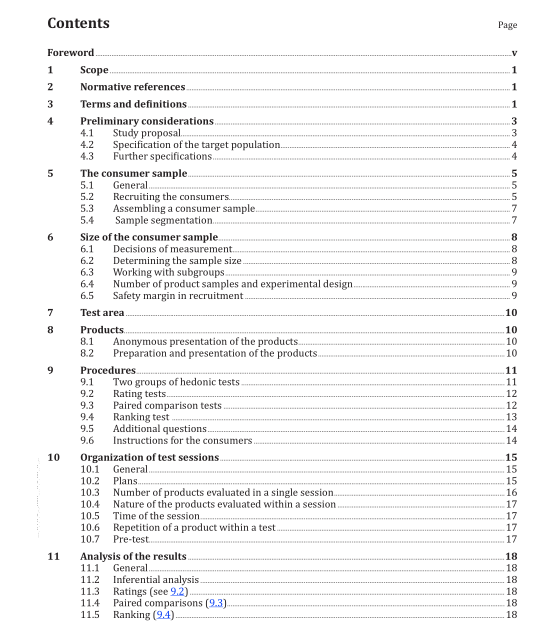ISO 11136:2014 pdf download.Sensory analysis — Methodology — General guidance for conducting hedonic tests with consumers in a controlled area
4 Preliminary considerations
4.1 Study proposal
The study proposal is drawn up by the service-providing laboratory based on the information (especially concerning the objective of the study and target population) given by the commissioning party, as a written document that binds the laboratory and the commissioning party contractually. It includes the following elements:
— the objective of the study;
— the products to be evaluated (and the procedures for their procurement, especially when the laboratory has to procure one or more products);
— the target population for the study;
— the size of the consumer sample (sample size) and the way it is to be recruited;
— any limitations on consumers’ prior history of participation in consumer studies;
— any limitations on other products to be evaluated in the same testing session;
— the evaluation conditions;
— the type of interview (self-completion forms or interviewers);
— the questionnaire;
— the place of evaluation;
— the number of products to be evaluated per session in the proposed study, together with an indication of other products to be evaluated where the session comprises several product families (where these products are not known at the time of drawing up the proposal, the laboratory should be committed to communicate them as soon as the laboratory knows the nature of the products);
— the conditions of preparation specific to the products to be evaluated (if they are known at this stage);
— any instructions specific to the products to be evaluated (if they are known at this stage) together with any specific information to be given about the products or the test at the start of the session;
— the name of the statistical tests to be used for interpreting the results; the type of risks used and their tolerable values; the magnitude of the minimum difference to be detected in a difference of liking test or of the maximum tolerable difference in a similarity of liking test;
— any envisaged segmentation of the consumer population, based either on characteristics known
before obtaining judgment data or from the responses obtained;
— the method of examining and summarizing open-ended questions;
— any recommendations the commissioning party wishes the laboratory to draft on the basis of the results;
— the dates envisaged for the tests and for submission of the report.
When any of the above elements are unknown at the time of the study proposal, the proposal includes for each element concerned the following statement: “This element will be specified by the commissioning party by… [specifying the stage of the study].”
NOTE If a specification already exists, the study proposal may make reference to it without repeating technical points described in an operational manner in the specification.
4.2 Specification of the target population
In order to specify the target population, it is necessary to answer the following questions. These questions shall be considered for each test to be performed because the consumer target group can be different from one test to the next, even for the same product.
— Has the product to be tested already been introduced on the market If so, is it possible to distinguish between actual and potential consumers
— Are the consumers of interest those who actually use the product, potential consumers who have not been using the product or both groups
— Are results from specified subgroups to be examined and compared
— Are the results of the total consumer sample to be analysed with a view identifying subgroups
— Are differences between the results of individuals of interest
4.3 Further specifications
Subsequent to specifying the target population, the following aspects shall be specified:
— place of test (see Clause 7);
— expected precision of measurement (see 6.1);
— test method (see Clause 9);
— product presentation plan for the test methods selected (see 10.2);
— specifications for the hypothesis to be tested (see 6.1);ISO 11136 pdf download.ISO 11136-2014 pdf download
